How To Conduct One On Ones
One-on-one meetings are encouraged between team members, and specifically when conducted by team leaders or managers on a regular basis, especially during periods of increased workload or when specific issues arise.
These sessions serve as valuable opportunities for feedback, guidance, and mutual understanding. Whether for performance evaluations, career development, or addressing concerns, 1:1 meetings are a proactive approach to fostering a supportive work culture.
Most notably, a 1:1 meeting doesn't have to be a formal, ceremonial event. When you feel the need for interpersonal discussion on these topics, just call your colleague and make it happen.
This page explains what to do in these instances to come prepared to the discussion and leave it with a well-documented record for future reference for both parties.
Preparing for the meeting
To streamline the 1:1 process, we provide templates tailored to various objectives, such as performance reviews, goal setting, or general check-ins. These templates can serve as a structured foundation for productive discussions.
Usually you may want to choose one of the available templates to keep things consistent, but that's not mandatory.
Most important is you understand some key aspects of an effective one-on-one meeting.
Certainly! Here are five quick pieces of advice for conducting a 1:1 meeting with an employee, especially for someone who is new to the process:
- Establish a Positive Environment: Create a comfortable and open atmosphere, and show genuine interest in the employee's well-being and contributions.
- Active Listening: Prioritize active listening over speaking. Allow the employee to express their thoughts and concerns.Use open-ended questions to encourage detailed responses and understanding.
- Goal-Oriented Agenda: If you decide not to use a template, make sure you have a clear agenda for the meeting. No matter the main topic, do your best to exit the meeting with a small set of relevant goals. Occasionally 1:1 meetings can be used to vent out stress, but don't overdue this or these meetings will be just amplifiers of discontent.
- Constructive Feedback: Provide specific and constructive feedback on achievements and areas for improvement. Offer praise for notable accomplishments and address challenges collaboratively.
- Encourage Two-Way Communication: Create a dialogue where the employee feels comfortable sharing their thoughts and ideas. If you are in a lead position, ask for feedback on your leadership style and inquire about any support or resources they may need.
Initiating a 1:1
Everyone can schedule or initiate a 1:1 on PeopleForce, our HR tool of choice, that can be accessed by every employee.
You can find the 1:1 scheduling button on your PeopleForce homepage, right under the title (1):
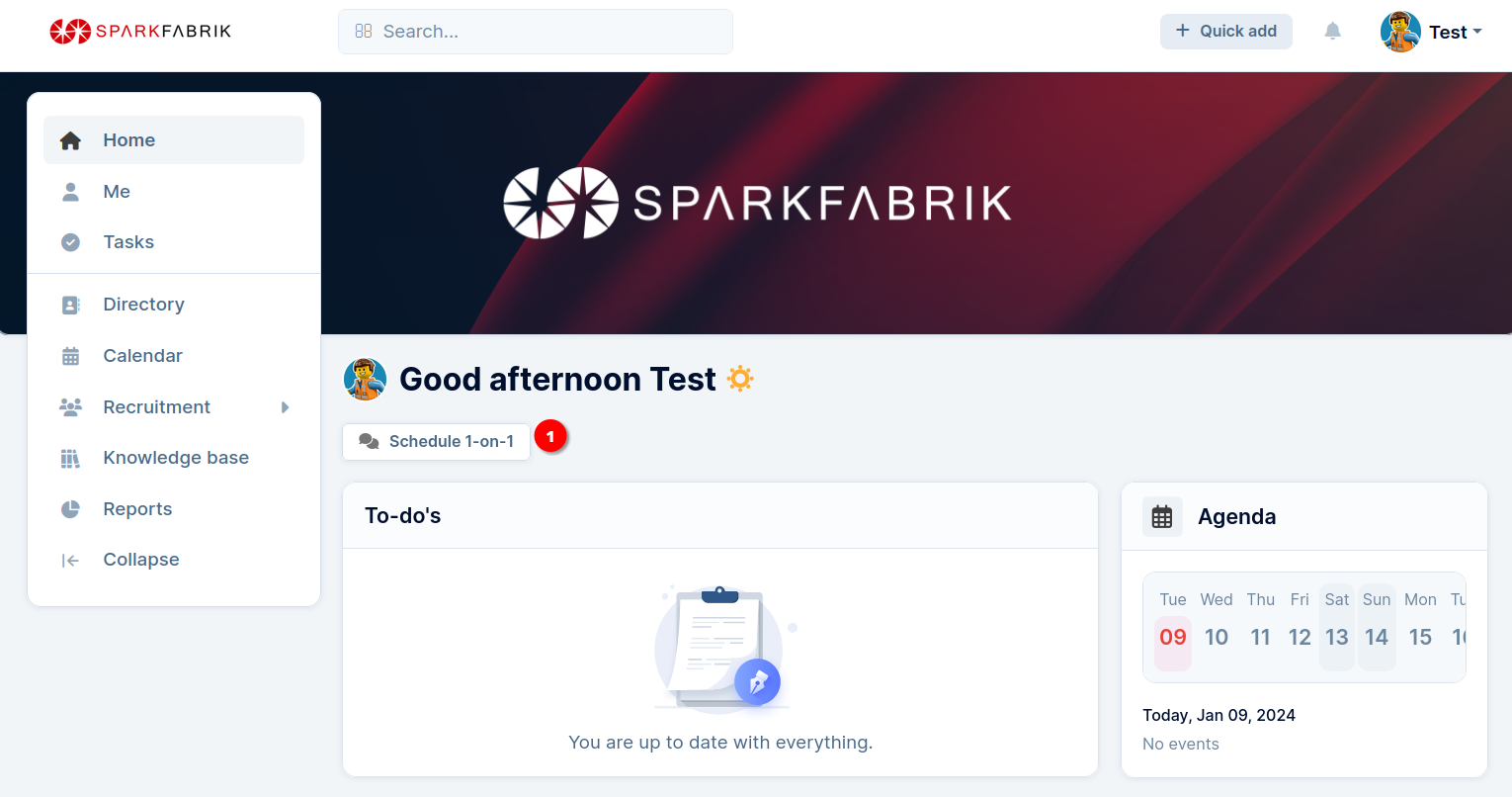
Click it to open a scheduling form and chose the person you will have a 1:1 with (2), the calendar schedule (3), and choose one among the available templates (4), if you prefer to have one.
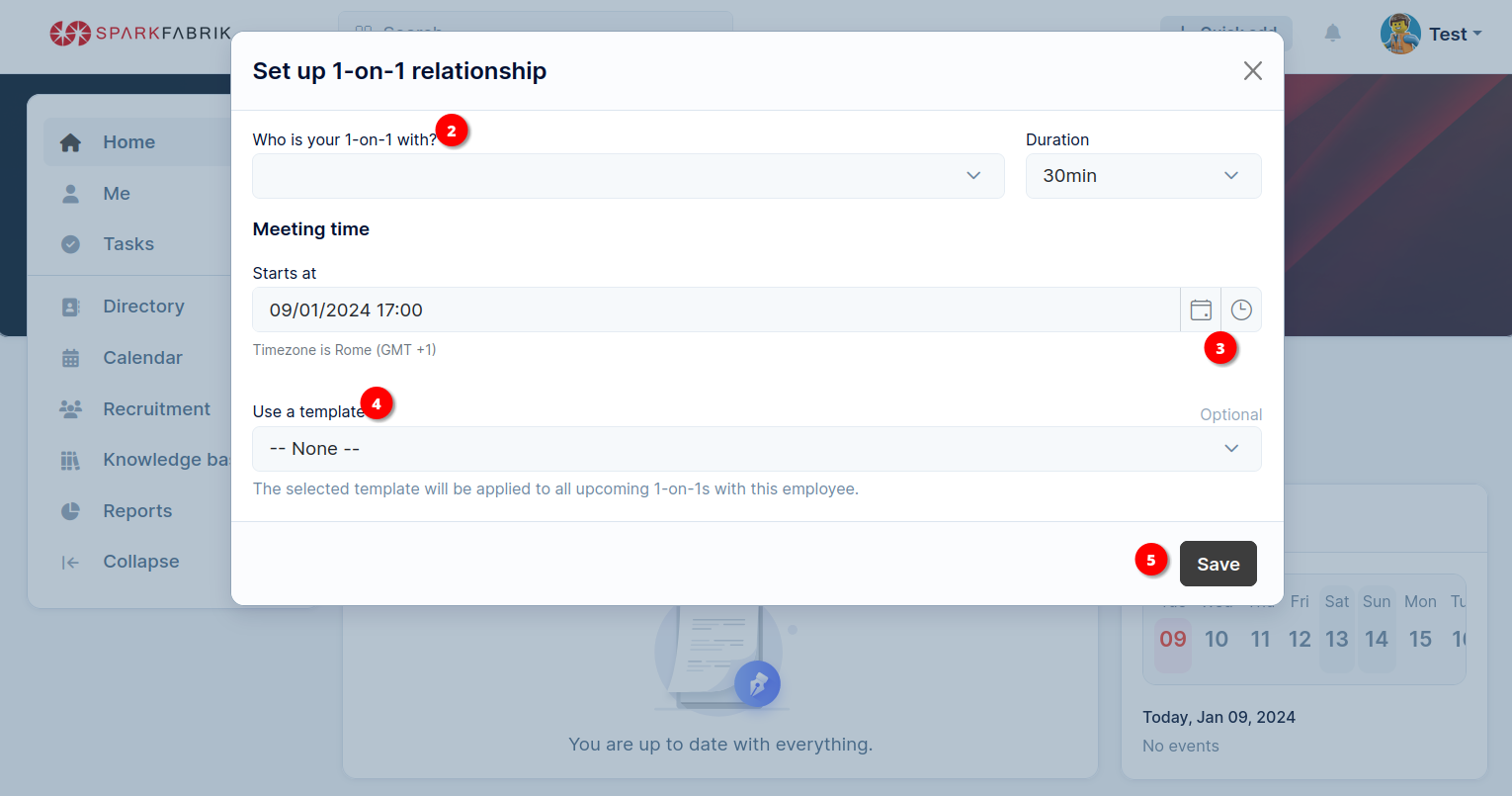
Clicking Save (5) will automatically set the event on the Calendars of both participants. Invitation have to be accepted.
Tip: It's usually better for the Team Leader, or Manager to schedule the event with the team mate or employee, because some template have visibility rules for talking points that work better that way.
Once saved, you will be directed to the 1:1 detail page.
If the event is not going to happen immediately, you can close the page. The link to it will be in the Calendar event and you can quickly access it from your homepage or the "Me" item in PeopleForce's main menu.
Recording Outcomes
During the 1:1, you should take notes and keep track of the outcomes. For that, just head to the 1:1 detail page:
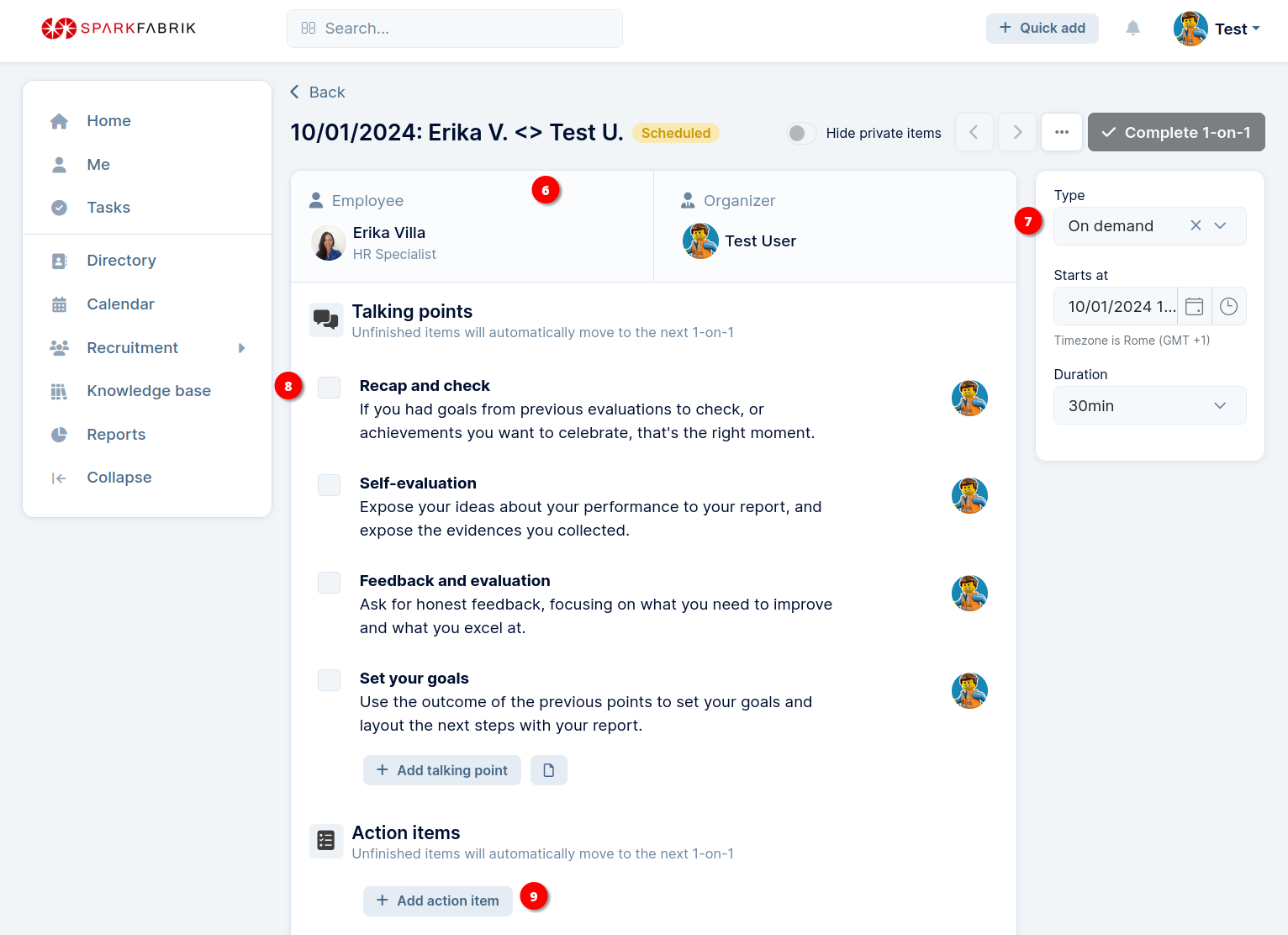
Atop the page you can see who's participating (6), useful if you have many such events scheduled in the same period.
Please, set the Type field (7) to On demand (if the 1:1 is sporadic or occasional), or any other relevant value (if in doubt, keep On demand).
During the 1:1 keep an eye on the talking points that come with the template. You can go through them one by one, or just go with the flow and use them to check if you forgot something by the end of the meeting. Anyway, make sure you mark out all the talking points you actually addressed, and leave the others marked out. This will be useful in retrospective.
If during the conversation you come up with practical goals and action items, use the appropriate section to add them (9). Each action item has a description, an assignee (among the participants) and can be set Visible (to both participants) or Private (visible to the assignee only).
Once added, Action Items may be marked out at any time, by the assignee.
Tip: Action Items, with their status, will be shown in the detail page of the next 1:1 that you create with the same participants. It will be possible to check them out even during the next meeting. This is pretty useful to keep an eye on the practical outcomes and keep the focus on "doing".
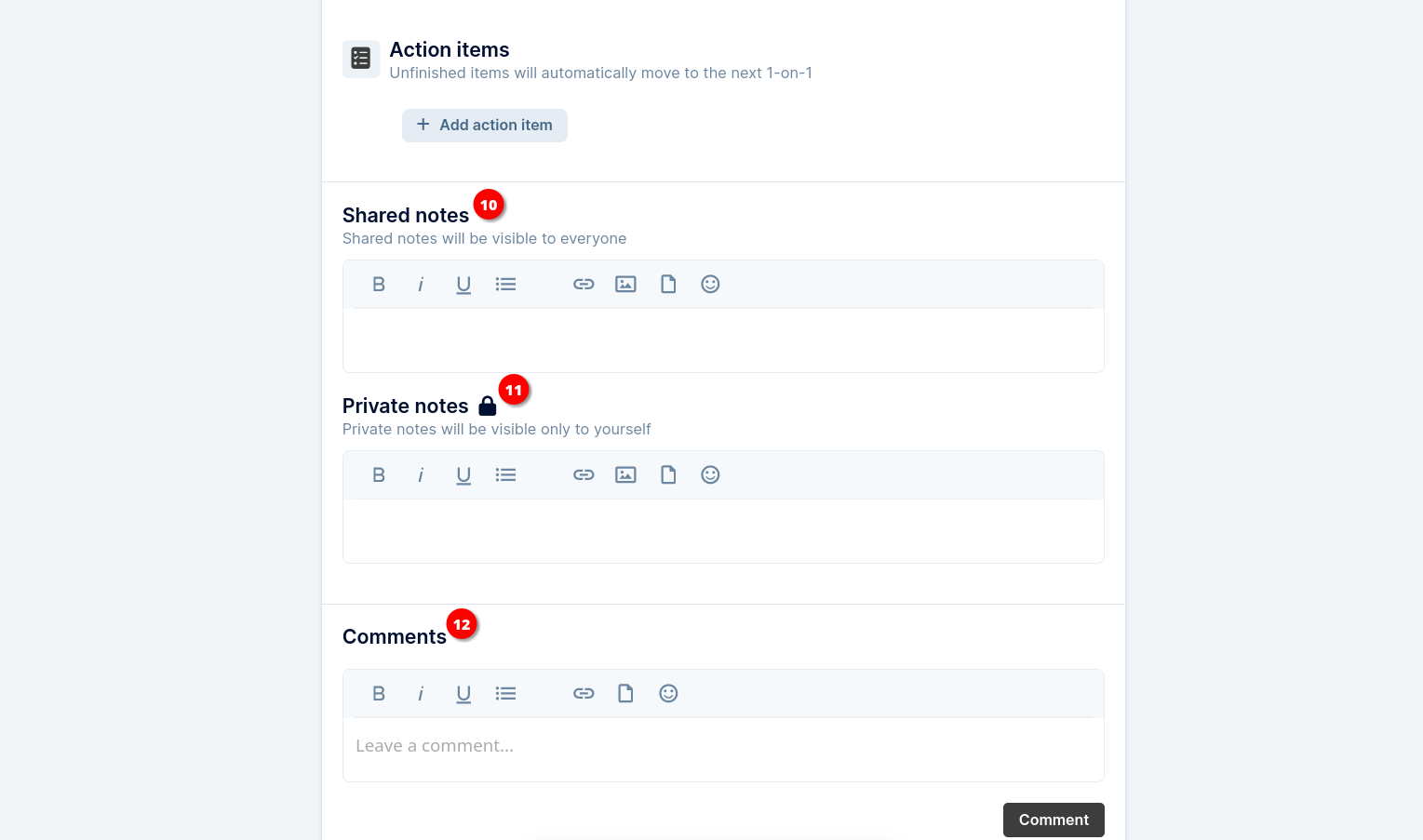
While talking, it is possible to take extensive notes (10) visible to both participants, and even private notes (11) visible only to the single participant who writes them.
We encourage you to take relevant notes on hot topics, achievements, problems, and whatever may help you recover the conversation from your memory.
Comments (12) can be added at any time, even after the 1:1 is over, and can serve as an ongoing async discussion.
Tip: We don't use comments much: our dimension does not justify having such async discussions, and usually it's better to have a quick talk and move on. Still one may want to note down progresses or impedements towards their goals and action items to have them ready at the next meeting. That's a good use of this feature.
Important: 1:1s records are visibile only to the two meeting participants, plus to the HR department and the platform administrators (currently only Company Board members have administration rights on PeopleForce). With the exclusion of the mentioned categories, the content of the meeting remain private. Private Notes are completely private to yourself only and not even the platform administrators can view them.
Once the 1:1 is over, you must complete it with the button on the right (13).
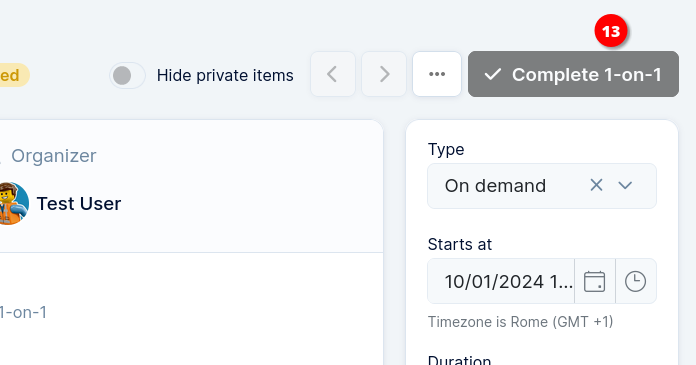
If you forget to complete your 1:1, the platform will send you email reminders, starting from the day after the scheduled event.
Once the 1:1 is completed, you can't edit its content with the exclusion of adding comments.
Escalation Protocol
In the event that certain issues surpass the scope of a direct resolution within the 1:1 setting, we emphasize the importance of escalation.
If sensitive topics or conflicts arise that require additional support, team leaders are encouraged to escalate the matter, reporting it to HR representatives, who are equipped to address more complex matters and provide a confidential and impartial perspective.
Of course, team leaders may want to escalate to other functions, like the CTO, or other area responsibles for very specific matters. Use your judgment to find who is better suited to address what's out of your control and, if in doubt, rely on HR to assist and route your requests.
